Here is a wonderful story of an icon writer from
Silvia Dimitrova's webpage can seen here.
May God grant Silvia many years!
Here is a wonderful story of an icon writer from
Silvia Dimitrova's webpage can seen here.
May God grant Silvia many years!
A question of what is the difference between the March and July observances of the feast of Saint Benedict.
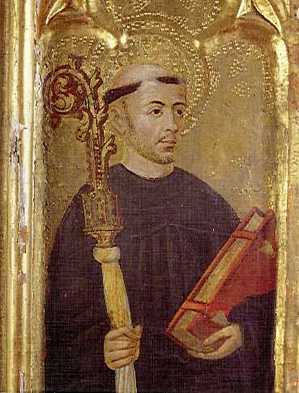 The July feast was the one celebrated in
The July feast was the one celebrated in
The Church, however, certainly never rejected the July 11 feast, as the celebration of the translation of the bones is really not about Fleury-vs.-Monte
March 21 is the feast of Saint Benedict's death. It more specifically concerns his entry into heaven and his role as Father of Western Monasticism.
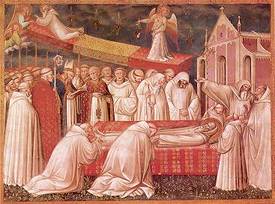 Let the whole multitude of the faithful exult in the glory of our beloved Father Benedict; but most of all let that army of monks be glad who on earth are celebrating the feast of him with whom the Saints in heaven are rejoicing. (Magnificat antiphon)
Let the whole multitude of the faithful exult in the glory of our beloved Father Benedict; but most of all let that army of monks be glad who on earth are celebrating the feast of him with whom the Saints in heaven are rejoicing. (Magnificat antiphon)
Today was a glorious day. The weather was particularly beautiful and the grounds of the Abbey and College were manicured on Friday plus the flowering trees are bursting forth with color. Our many guests attested to value of the charism of Saint Benedict and the witness of the monastic community here in the Charlotte metro area. We can say that the monks and friends are intertwined in a very real way.
The 4th bishop of the Diocese of Charlotte, the Most Reverend Peter J. Jugis, JCD, presided his choir robes and many priests of the diocese concelebrated the Mass with Father Abbot Placid, celebrating. All of the monks and guests staying at the abbey were present. It was particularly fitting to have some of the priests of the diocese who in some way collaborate with the abbey here because of the strong connection that exists between the abbey and the diocese: the abbey was the seat of the diocese and the monks either founded and staffed some of the parishes or provided weekend assistance. Heartwarming for me was the clear sense of fraternal love and unity with Saint Peter in the Episcopal office with the presence of Bishop Jugis because there are monasteries live in friction with the local bishop and by extension the Holy Father. Hence it was evident to me that there's been a genuine affection between the bishop and the monks. I'd be remiss if I didn't mention the presence of the Religious Sisters of Mercy. They've held a close relationship with the monks of this abbey since the 19th century and the monks continue to be their chaplains down to today.
As an historical note, the Holy See erected the Diocese of Charlotte on
In the homily Father Abbot spoke of Saint Benedict personally hearing the voice of Christ calling him to follow. As Benedict listened with the ear of his heart, so we should listen to the call of the Master (Christ). We know that through baptism we are reborn as adopted children of God and our lived experience tells us that we are being formed into saints, or at least the hope is that we'd become saints. Being a saint, however, is not being a plastic sort of character but a person who really lives what his conviction in Christ is. It's the saint that lets know that God is real and that His love and creative power endures; it's the saint that knows and shows us that the divine promise is a fact. Two aspects of this the divine promise bear mentioning because they are constituent parts of Benedict's life: forgiveness (mercy) and providence (life will be set right). In forgiveness our sins are forgiven and we are given the grace to transform our lives from ugliness to beauty.
The abbot also noted for us that Benedict is an example of being "watchful" in the face of grace and sin; he was attentive to sustaining others in the struggle against Satan. One can say, therefore, that Benedict is a living Gospel: he lived the Gospel faithfully and his witness to Christ was substantial. While it seems odd that on a joyous occasion such as this feast to tell people to keep death before our eyes as Benedict admonished his monks, it is nevertheless true that we ought to do so because it is an expression of Christian hope: we desire our destiny, we desire the infinite. As Pope Benedict reminded us in last encyclical, the distinguishing mark of the Christian is that we know we have a future. Just as Saint Benedict was converted, the abbot said, by the Paschal Mystery of the Lord, so by that same Mystery shall we be transformed if we give ourselves over the Lord without reserve.
One may note in the Ordo for liturgical services that March 21 is a liturgical memorial of Saint Benedict, co-patron of
By the use of the word "solemnity" I mean the use of festive hymns and antiphons for the saint or the Lord are sung, incense and white vestments are used, and the Gloria is sung and the Creed recited at
For the monks of Belmont solemnities never end: the anniversary of the Dedication of the Abbey Church falls on March 28 but that day, even though it is a solemn occasion, will be simplified I can assure you. All these special celebrations can obscure the sober liturgical sense that's supposed to be followed for Lent and yet there is a particular Catholic sense of the Incarnation that's manifested when we properly observe feasts on their proper days. Given that Mary, Help of Christians -
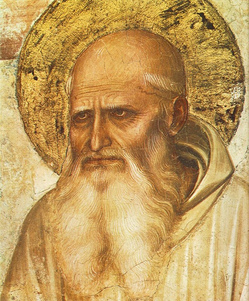 At the solemn Vespers last eve, the Father Abbot was suitably decorated in mitre with crosier, symbols of his office as a head of the abbey. A special vesperal hymn for the Transitus of Benedict, "Whate'er of Yore," was sung. According to Father Prior this hymn is of unknown provenance and yet highly revered. It speaks of the prophets and the Law, Abraham and Moses, perfect virtue, especially asceticism, obedience and peace viz. the witness of blessed Benedict amidst the storms of era. The lyrics bear our attention:
At the solemn Vespers last eve, the Father Abbot was suitably decorated in mitre with crosier, symbols of his office as a head of the abbey. A special vesperal hymn for the Transitus of Benedict, "Whate'er of Yore," was sung. According to Father Prior this hymn is of unknown provenance and yet highly revered. It speaks of the prophets and the Law, Abraham and Moses, perfect virtue, especially asceticism, obedience and peace viz. the witness of blessed Benedict amidst the storms of era. The lyrics bear our attention:
Whate'ver of yore the tuneful prophets teach
Or Law of olden days,
Great monarch of ascetic multitudes,
Thy life displays.
A glorious progeny is Abram's boast;
Meekness in Moses shone;
Faultless obedience and a beauteous spouse
Were Isaac's crown.
But our exalted heav'nly Patriarch,
Immeasurably blest,
Concentrates all their glory, virtue, praise,
In his sole breast.
O may his arm of might that caught us up
From the world's stormy tide,
Here keep us evermore where halcyon calm
And peace abide.
Glory eternal to the Father be,
And sole-begotten Son,
With Thee Great Paraclete: eternal Three
And trinal One.
The reading at Lauds this morning is both apropos for Lent and for the Solemnity of Saint Benedict. Father Abbot, decorated with a beautiful pectoral cross of ancient days, read Sirach 2:1-18. Without knowing at first where the reading came from, I first thought it to be from one of the Fathers of the Church, or even Pope Benedict; all of what Sirach speaks of resonates strongly for me because it corresponds with what I've experienced and know deeply in my heart, and I hope it's the similarly for you. The text follows:
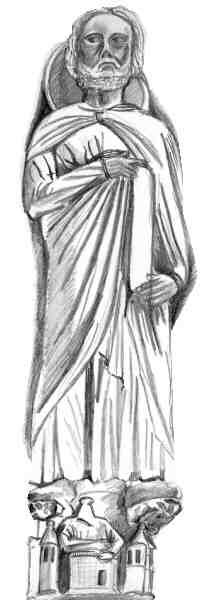 My son, if you come forward to serve the Lord, prepare yourself for temptation. Set your heart right and be steadfast, and do not be hasty in time of calamity. Cleave to him and do not depart, that you may be honored at the end of your life. Accept whatever is brought upon you, and in changes that humble you be patient. For gold is tested in the fire, and acceptable men in the furnace of humiliation.
My son, if you come forward to serve the Lord, prepare yourself for temptation. Set your heart right and be steadfast, and do not be hasty in time of calamity. Cleave to him and do not depart, that you may be honored at the end of your life. Accept whatever is brought upon you, and in changes that humble you be patient. For gold is tested in the fire, and acceptable men in the furnace of humiliation.
Trust in him, and he will help you; make your ways straight, and hope in him. You who fear the Lord, wait for his mercy; and turn not aside, lest you fall. You who fear the Lord, trust in him, and your reward will not fail; you who fear the Lord, hope for good things, for everlasting joy and mercy. Consider the ancient generations and see: who ever trusted in the Lord and was put to shame? Or who ever persevered in the fear of the Lord and was forsaken? Or who ever called upon him and was overlooked? For the Lord is compassionate and merciful; he forgives sins and saves in time of affliction.
Woe to timid hearts and to slack hands, and to the sinner who walks along two ways! Woe to the faint heart, for it has no trust! Therefore it will not be sheltered. Woe to you who have lost your endurance! What will you do when the Lord punishes you? Those who fear the Lord will not disobey his words, and those who love him will keep his ways. Those who fear the Lord will seek his approval, and those who love him will be filled with the law. Those who fear the Lord will prepare their hearts, and will humble themselves before him. Let us fall into the hands of the Lord, but not into the hands of men; for as his majesty is, so also is his mercy.
 On the eve of the Solemnity of Saint Benedict, it is good to think with what the various popes have said about this famous and holy monk, Saint Benedict:
On the eve of the Solemnity of Saint Benedict, it is good to think with what the various popes have said about this famous and holy monk, Saint Benedict:
After his pious death, when the holy Patriarch went to heaven, the Order of monks he founded was far from failing or collapsing; rather, it seemed not only to be over nourished and strengthened by his living example, but also to be supported and vivified by his heavenly patronage, so that it went on increasing year by year. (Pope Pius XII, 1947)
When darkness seemed to be spreading over
At the heart of St. Benedict's monastic experience is a simple, typically Christian principle, which the monk adopts in all its radicalness: to unify one's life around the primacy of God. This "tenere in unum", the first, fundamental condition for entering monastic life, must be the commitment unifying the life of the individual and the community, and be expressed in the "conversatio morum" which is fidelity to a life-style lived concretely in daily obedience. The search for Gospel simplicity requires continual examination, that is, the effort "to do the truth", by constantly returning to the initial gift of the divine call which is at the root of one's own religious experience. (Pope John Paul II, 1999, 1500th anniversary of the founding of Subiaco)
...with his life and work St. Benedict exercised a fundamental influence on the development of European civilization and culture" and helped
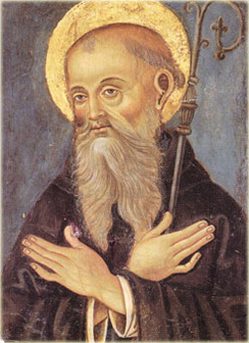 O Glorious St. Benedict, sublime model of all virtues, pure vessel of God's grace! Behold me, humbly kneeling at thy feet. I implore thy loving heart to pray for me before the throne of God. To thee I have recourse in all the dangers which daily surround me. Shield me against my enemies, inspire me to imitate thee in all things. May thy blessings be with me always, so that I may shun whatever God forbids and avoid the occasions of sin.
O Glorious St. Benedict, sublime model of all virtues, pure vessel of God's grace! Behold me, humbly kneeling at thy feet. I implore thy loving heart to pray for me before the throne of God. To thee I have recourse in all the dangers which daily surround me. Shield me against my enemies, inspire me to imitate thee in all things. May thy blessings be with me always, so that I may shun whatever God forbids and avoid the occasions of sin.Graciously obtain for me from God those favors and graces of which I stand so much in need, in the trials, miseries and afflictions of life. Thy heart was always so full of love, compassion, and mercy towards those who were afflicted or troubled in any way. Thou didst never dismiss without consolation and assistance anyone who had recourse to thee. I therefore invoke thy powerful intercession in the confident hope that thou will hear my prayers and obtain for me the special grace and favor I so earnestly implore (mention it), if it be for the greater glory of God and the welfare of my soul.